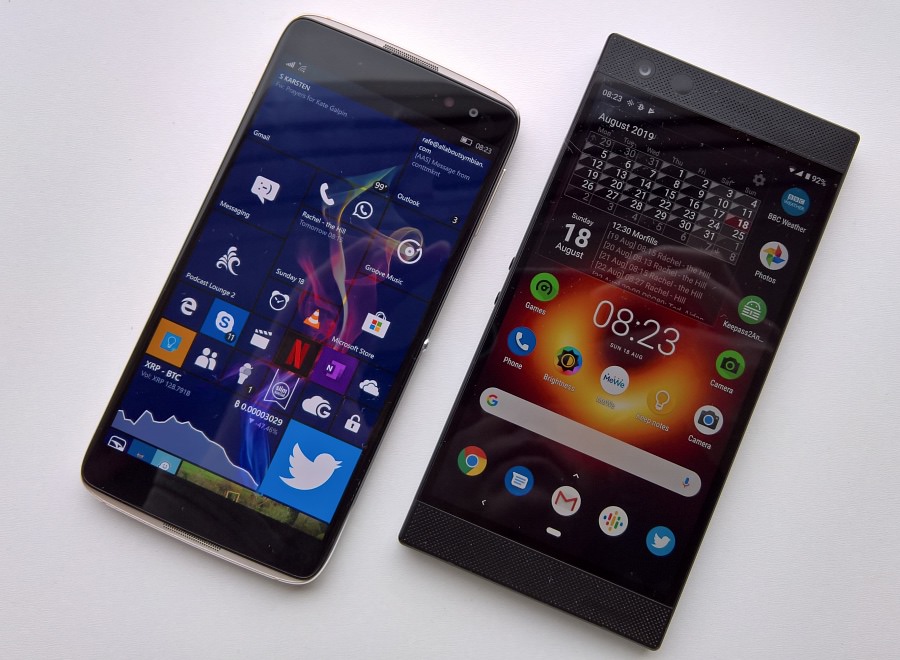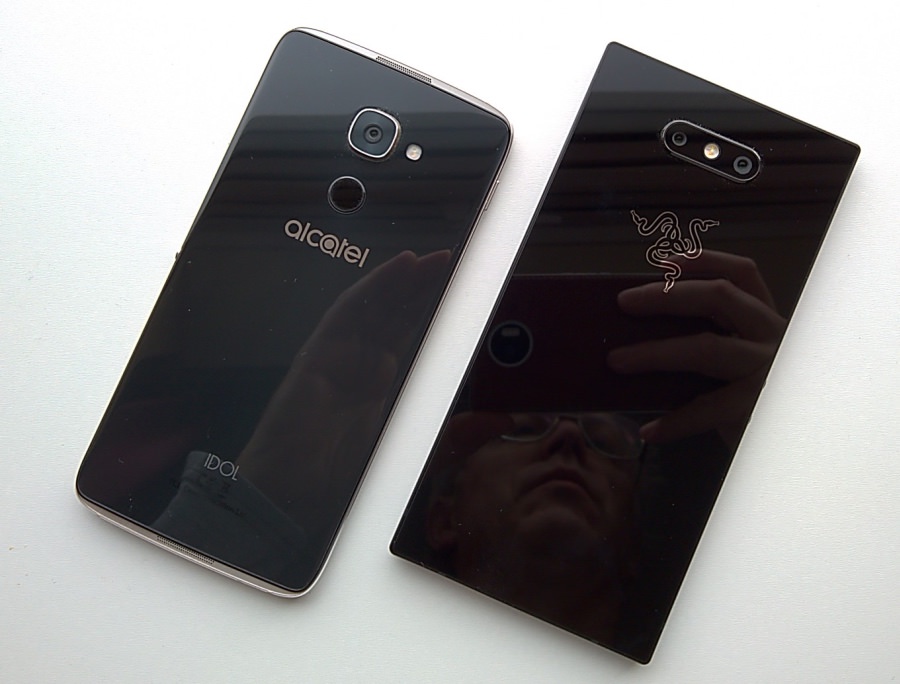
As usual, I've shaded in green an obvious 'win' for either device, I honestly have no idea which way this one's going to go (as I start to compile the feature)... Any row where a winner would be totally subjective is left uncoloured. Or, where both devices are utterly excellent but in different ways, I've given both a 'green'(!)
| Alcatel IDOL 4 Pro | Razer Phone 2 | |
| Date first available | August 2017 | October 2018 |
| Current price, availability | No longer available officially, see clearance bins around the world, or second hand. Suggested price £150-£200 | £399, SIM-free, inc VAT, from many Internet sellers now (it started at £799!) |
| Dimensions, form factor, weight, design |
154 x 75 x 7mm, aluminium frame with toughened glass front and back, 152g |
159 x 79 x 9mm, aluminium chassis, toughened glass front and back, 220g, larger in every dimension and heavier |
| Durability | No specific durability metrics, plus the dual sided glass design means a case is a must. If water gets in then you're pretty much out of luck. Sadly. |
IP67 rated, i.e. waterproof, though its super slippery again, so make sure to grab a TPU case (I use this one). |
| Operating system, interface | Windows 10 Mobile (now running Fall Creators Update), (dismissable) virtual controls |
Android 9.0, virtual controls, on-screen and with swipe gestures (NovaLauncher) |
| Display |
Samsung-made 5.5" 16:9 AMOLED 1080p panel, Dragontrail Glass, excellent colour balance, contrast and viewing angles. Screen area is approximately 84 cm2 |
5.7" 16:9 IPS LCD 1440p screen, Gorilla Glass 5, very decent when cranked to 100% brightness, indoors, though always playing second to AMOLED when it comes to 'enjoying' what's presented, since you're always aware of the backlight. Outdoors, the IPS LCD is hard to see, I was disappointed with contrast in sunny conditions. Refresh rate goes 'up to' 120 Hz, though my eyes can't see a difference from the 60Hz of other phones and so I just can't give credit or a win here. Screen area is approximately 90cm2 |
| Connectivity | LTE, Wi-Fi b/g/n/ac, integral wifi tethering, Bluetooth 4.1, Continuum connectivity to use external displays as secondary screen, independent of the phone display. Note that - perhaps significantly - there's no NFC! | LTE, NFC (all uses), Wi-Fi b/g/n/ac, integral wifi tethering, Bluetooth 5.0 (all uses). NFC is a pro for the Razer, but Continuum is also powerful, so a score draw here! |
| Processor, performance | Snapdragon 820 chipset, 4GB RAM (of which 3.5GB are used directly), the fastest Windows phone I've tested so far, despite the lack of TLC from Microsoft or Alcatel in terms of tuning | Snapdragon 845 with 8GB RAM. Very fast at everything |
| Capacity | 64GB, expandable via microSD for card swapping | 64GB internal storage, expandable via microSD for card swapping |
| Imaging (stills) |
21MP f/2.2 1/2.4" BSI sensor, dual LED flash, HDR shots, PDAF, very decent shots in most light conditions, but capture is relatively slow and it all falls down in really low light, as you'd expect (with no OIS). See my review part 2. 8MP front camera |
Cameras: 12 MP main, f/1.8, 1/2.55", dual pixel PDAF, OIS 12 MP telephoto, f/2.6, 1/3.1", 2x optical zoom Very decent results in all conditions - not 2019 flagship level per se and not worth me even doing a Lumia shootout, but there are excellent Google (Pixel) Camera ports which work even better (including Night Sight). Loads of options to play with, anyway. 8MP front camera, f/2.0 |
| Imaging (video) | 4K, optionally digitally stabilised (EIS), with 'Best photo' 8MP grabbing built-in, plus high amplitude stereo audio recording. See my review part 3. | Up to 4K video capture, with good stereo audio capture. Stabilisation is buggy though, even at 1080p, and footage was jerky. Clearly work to do for Razer here. |
| Speakers | Great front-facing JBL-tuned 3.6W stereo speakers, the best in the phone world when launched (other than my beloved Marshall London RIP), loud and clear, perhaps lacking only a little in bass. | Punchy, average volume stereo speakers, but taken to impressive levels in volume and EQ for most content with Dolby Atmos software enhancement. Gets the win here for the end result, even though what I'd really like to have seen would be Dolby Atmos on the larger Alcatel JBL speakers! |
| Headphone output |
3.5mm headphone jack, driven by a power amp and pro-quality DAC. Stunning. | No 3.5mm jack built-in, instead Razer puts a high quality 24-bit DAC in a Type C dongle (in the box) that's the equal of that put into the IDOL 4 Pro. Though you do have to remember to keep the dongle with you (and not lose it! If you do, get this one), and - for that reason alone - I have to give the Alcatel the win. |
| Navigation | Windows 10 Maps is comprehensive, has a degree of live traffic awareness (see the latest workaround), Includes full offline maps with automatic updates. |
Google Maps is now the gold standard in phone navigation, tied in with many other Google services and offering true real time navigation around traffic issues. |
| Cortana/Voice | Cortana is now mature and well integrated, and with a surprising degree of 'assistance'. | Google Assistant is baked in and works well (activated from the Google search bar, a long press on 'home', or via voice). It's now the premier voice assistant in terms of what it can reply to (and I've tested it a lot). |
| Battery, life |
Sealed 3000mAh battery, just about gets through a day even with Windows 10 Mobile(!) Plus USB Type C fast charging (up to 2A) and compatibility with Qualcomm's Quickcharge 3.0 (up to 18W). No Qi wireless charging. |
Sealed 4000mAh battery, just about gets through a day. I'd have expected more, but suspect the need to keep the screen at maximum brightness much of the time is the main culprit. Charging is up to 18W through the USB Type C port with Quick Charge 4 spec. Qi wireless charging up to 15W if your pad supports it, and Qi is what gets the Razer the win here. |
| Cloud aids | Windows Photos runs at full resolution and quality, and syncs across all signed-in devices, subject to your OneDrive tariff, should you have thousands of images in the system. Plus Windows 10 backs all your media, application data and settings to a separate backup folder system, tariff-free on OneDrive. | Google Photos, once installed, does a great job of organising photos and syncing them across all signed-in phones and tablets, albeit at 'reduced' quality (re-compression server-side). |
| File compatibility | As with all Windows phones, plugging into a Windows PC gives full drag and drop to the phone's user file system. Plugging into a Mac sadly isn't possible anymore. | Plugging into a PC gives immediate MTP file access, plus this works well on a Mac with Google's Android File Transfer utility, for drag and drop of all user files. |
| Biometrics | The fingerprint sensor is slower than most in the industry, and it's not clear why! Plus the 'Hello' animation takes a second. On the positive side, it's a lot faster than PIN entry or iris recognition. On the (other) negative side, there's no Microsoft Wallet/Pay. Or NFC. So that side of things is a no go. | The fingerprint sensor is in the power button and works really well, though I was disappointed that a simple touch isn't enough to get into the phone - you actually have to press the button as well (first world problems, eh?!) Way faster that the half-assed implementation on the Alcatel. Works well with Android Pay. |
| Applications and ecosystem | Windows 10 Mobile now has just about every mainstream app covered, aside from Snapchat and Tinder. And anything to do with Google services! Most things can be done via Edge, though 'not quite' as slickly as with dedicated applications. | The might of Google and Android's app ecosystem - everything is available and almost always in first party form. |
| Upgrades and future |
Windows 10 Mobile will be updated until the end of 2019, of course, as part of the global Windows 10 ecosystem and the regular patching and fixing process. Production devices can expect updates every month. The future (2020-) is looking a bit bleak though. |
In theory, this should be updated through 2019 at least. In practice, Razer has seemingly abandoned it on February 2019 security status. Users are clamouring for Razer to do something about this and I've a hunch that there will be a big update in the next few months. But no guarantees. |

Verdict
Adding up the green 'wins' gives a resounding 11-4 score in favour of the much newer device, of course, though the IDOL 4 Pro still holds up well in many ways, for a phone which started life in 2016 (in the USA). The Razer Phone 2 isn't perfect by a long way, but it does offer a lot of power and a few USPs along the way, all for a potential bargain price now (£399). My recommendation isn't outright yet though - I'm waiting for Razer to convince me by shipping some OS/security updates for their flagship! (In the meantime, see my OnePlus 7 Pro head to head.)
Comments welcome - maybe you've tried a Razer Phone 2 yourself? Does it beat out the Pixels and Galaxy phones for an ex-Windows user?
